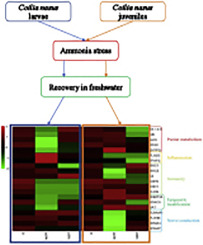当前位置:
X-MOL 学术
›
Comp. Biochem. Physiol. C Toxicol. Pharmacol.
›
论文详情
Our official English website, www.x-mol.net, welcomes your
feedback! (Note: you will need to create a separate account there.)
Transcriptomic analysis reveals different responses to ammonia stress and subsequent recovery between Coilia nasus larvae and juveniles.
Comparative Biochemistry and Physiology C: Toxicology & Pharmacology ( IF 3.9 ) Pub Date : 2020-01-17 , DOI: 10.1016/j.cbpc.2020.108710 Jun Gao 1 , Yongxiang Zhu 2 , Zhenglong Guo 2 , Gangchun Xu 3 , Pao Xu 3
Comparative Biochemistry and Physiology C: Toxicology & Pharmacology ( IF 3.9 ) Pub Date : 2020-01-17 , DOI: 10.1016/j.cbpc.2020.108710 Jun Gao 1 , Yongxiang Zhu 2 , Zhenglong Guo 2 , Gangchun Xu 3 , Pao Xu 3
Affiliation

|
Excessive ammonia triggered negative effects on aquatic animals' health, growth, and mass death, especially at different developmental periods. However, the underlying responses to ammonia stress in fish larvae and juveniles were much less explored. Transcriptomic analysis of Coilia nasus larvae and juveniles treated with ammonia stress and subsequent recovery in freshwater were performed. Total 958,213,132 clean reads were obtained. A total of 234,830 unigenes with an average length of 1397 bp and N50 value 2521 bp were assembled. 831 and 952 DEGs were identified in C. nasus larvae and juveniles, respectively. Transcriptomic analysis revealed that genes associated with purine metabolism, immune, inflammation, epigenetic modification, and nerve conduction presented different expression trends between C. nasus larvae and juveniles. Other genes related to purine metabolism (XDH) and epigenetic modifications (DNMT1, DNMT3A, and DNMT3B) detected by RT-qPCR also displayed different expression trends. These results indicated that ammonia detoxify strategies and gene regulation patterns were different in C. nasus larvae and juveniles. Higher TNF-α, ILF-2, and ILF-3 expression and reduced LZM, AKP, and ACP activities suggested that inflammation and declined immunity were triggered by ammonia stress. Additionally, nervous conduction was severely affected under ammonia stress in C. nasus juveniles. Furthermore, recovery in freshwater had positive effects on nervous conduction. However, it was worth noting that reduced immunity and inflammation were still existed after recovery in freshwater. In conclusion, our study would be beneficial to reveal the different responses to ammonia stress between larvae and juveniles.
中文翻译:

转录组学分析揭示了Co虫幼虫和少年对氨胁迫和随后恢复的不同反应。
过量的氨对水生动物的健康,生长和大规模死亡造成负面影响,尤其是在不同的发育时期。但是,对鱼幼体和幼体对氨胁迫的潜在反应却少有研究。进行了用氨胁迫处理的Co虫幼虫和幼虫的转录组学分析,并随后在淡水中进行了回收。总共获得958,213,132次干净读取。总共234,830个单基因,平均长度为1397 bp,N50值为2521 bp。在鼻息肉幼虫和幼虫中分别鉴定出831和952个DEG。转录组学分析显示,与嘌呤代谢,免疫,炎症,表观遗传修饰和神经传导相关的基因在鼻息肉幼虫和幼虫之间表现出不同的表达趋势。RT-qPCR检测到的与嘌呤代谢(XDH)和表观遗传修饰相关的其他基因(DNMT1,DNMT3A和DNMT3B)也显示出不同的表达趋势。这些结果表明,氨氮解毒策略和基因调控模式在鼻息肉幼虫和少年中是不同的。更高的TNF-α,ILF-2和ILF-3表达以及降低的LZM,AKP和ACP活性表明,氨胁迫触发了炎症和免疫力下降。另外,在纳氏梭菌幼鱼的氨胁迫下,神经传导受到严重影响。此外,淡水中的恢复对神经传导有积极作用。但是,值得注意的是,淡水恢复后,免疫力和炎症仍然存在。结论,
更新日期:2020-01-17
中文翻译:

转录组学分析揭示了Co虫幼虫和少年对氨胁迫和随后恢复的不同反应。
过量的氨对水生动物的健康,生长和大规模死亡造成负面影响,尤其是在不同的发育时期。但是,对鱼幼体和幼体对氨胁迫的潜在反应却少有研究。进行了用氨胁迫处理的Co虫幼虫和幼虫的转录组学分析,并随后在淡水中进行了回收。总共获得958,213,132次干净读取。总共234,830个单基因,平均长度为1397 bp,N50值为2521 bp。在鼻息肉幼虫和幼虫中分别鉴定出831和952个DEG。转录组学分析显示,与嘌呤代谢,免疫,炎症,表观遗传修饰和神经传导相关的基因在鼻息肉幼虫和幼虫之间表现出不同的表达趋势。RT-qPCR检测到的与嘌呤代谢(XDH)和表观遗传修饰相关的其他基因(DNMT1,DNMT3A和DNMT3B)也显示出不同的表达趋势。这些结果表明,氨氮解毒策略和基因调控模式在鼻息肉幼虫和少年中是不同的。更高的TNF-α,ILF-2和ILF-3表达以及降低的LZM,AKP和ACP活性表明,氨胁迫触发了炎症和免疫力下降。另外,在纳氏梭菌幼鱼的氨胁迫下,神经传导受到严重影响。此外,淡水中的恢复对神经传导有积极作用。但是,值得注意的是,淡水恢复后,免疫力和炎症仍然存在。结论,











































 京公网安备 11010802027423号
京公网安备 11010802027423号